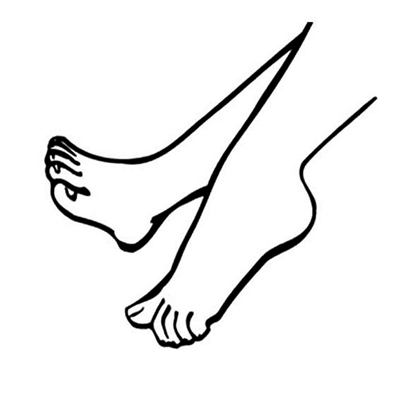
Swelling is called edema in medical terminology, which is more common in the ankle. Many people think that ankle swelling is caused by drinking too much water, but it is not. The website of American Journal of Prevention recently analyzed this and summarized 12 reasons for ankle swelling. Swelling If left untreated, swollen ankles will become painful, it will be difficult to walk, the joints will be stiff and the skin will be elongated. Even worse, swelling or blood clots, infections, and even signs of heart problems.
Sit or stand all day: If your work requires standing (or sitting) in one place for a long time, then ankle swelling is a natural phenomenon. Dr Steven winfield, director of the Department of Foot and Ankle Surgery at Mount Sinai Hospital in new york, explained: When you move around, the muscles involved in exercise help you to import body fluids and blood into and out of your limbs. However, without the help of muscles in motion, blood and body fluids will gather in the feet and ankles.
Side effects of pregnancy: among the many changes experienced by pregnant women during pregnancy, ankle swelling may be the most common. According to the American Pregnancy Association, this is mainly because the extra blood and body fluids produced by women during pregnancy soften the body and help it expand as the baby grows. Changes in hormone function and extra pressure in veins may also cause ankle swelling during pregnancy.
Injury: Whether you hit a table or sprained your ankle while running, injury is a common cause of ankle swelling. When the ankle is injured, the body will send extra blood to this area; This will not only bring healing cells, but also cause swelling, thus keeping the injured joint still. In the case of injury, swelling may also be accompanied by redness or bruising.
Infection is brewing: although untreated wounds around the ankle joint will infect the inside of the joint, any bacteria that enter the blood may eventually enter the joint. The most obvious signs of infection are swelling, tenderness, fever and redness.
Infants and the elderly are particularly prone to suppurative arthritis, that is, bacterial or fungal infection leads to joint inflammation, accompanied by redness, pain and fever. In addition, some skin diseases (such as cellulitis, a rapidly spreading bacterial infection, which makes the skin appear red and blistered) can also cause swelling of the ankle, because it often appears in the lower leg of adults.
Lymphedema: Lymphatic system transports lymph (including white blood cells and waste) to the whole body. However, for patients with lymphedema, their lymphatic system is damaged or blocked, resulting in lymph deposition at the distal end of the limb. Although some cancers (and cancer treatments) can cause lymphedema, infection can also stimulate swelling. Symptoms of lymphedema also include heavy or tight arms or legs, inability to move normally, repeated infections, skin hardening or thickening, and difficulty sleeping.
Weight gain: Overweight and obese people have swollen ankles for two reasons. First of all, the extra weight applied around the joint will cause fluid retention around the joint. In addition, excessive hormone storage in excess fat cells will also lead to changes in hormone function, resulting in fluid retention.
Taking certain drugs: Due to the complex interaction between drugs (including over-the-counter drugs) and the body, they may cause ankle swelling. Some drugs can cause fluid retention. Some drugs for treating blood pressure, anti-inflammatory steroids and even non-steroidal anti-inflammatory drugs (such as ibuprofen) have such side effects. Estrogen and some antidepressants can also cause ankle swelling.
Arthritis: Symptoms of arthritis include joint swelling, pain, stiffness and difficulty in moving. This disease is very common in the elderly and will affect all joints of the body, including the ankle. Inflammation associated with arthritis causes joint swelling.
Signs of blood clots: One of the most shocking causes of swelling around the ankle is blood clots (which usually spread further up the leg). If the swelling on one side continues to spread upward, it needs to be checked in time. In some cases, blood clots can enter the lungs and lead to life-threatening pulmonary embolism. If you notice other signs of thrombosis (such as pain, shortness of breath, dizziness, redness or discoloration of the skin), you should see the emergency department immediately.
Intravenous work is inefficient: venous dysfunction will affect blood circulation back to the heart, allowing blood to collect on the feet and ankles. With the passage of time, the stretching function of the one-way valve of vein becomes worse, which leads to liquid leakage. This happens when the valve is damaged or weakened due to aging or sedentary, which is more common in middle-aged and elderly women over 50 years old.
It may also be a symptom of heart problems: patients with congestive heart failure (caused by coronary heart disease or hypertension) have at least one ventricle that cannot pump blood normally. If the heart can’t pump enough fluid, the fluid will flow back. This usually happens in the feet and ankles, causing swelling. In more serious cases, it can extend up to the legs. Other symptoms of heart failure include shortness of breath or irregular heartbeat, persistent cough and chest pain.
There are liver or kidney problems: kidney and liver dysfunction will affect the content of body fluids, causing fluid retention and swelling of ankle joints. In the case of kidney damage or nephropathy, the kidney either leaves too much fluid and sodium, or there is not enough protein in the blood, which will lead to fluid accumulation in the lower limbs. When renal failure occurs, swelling and tenderness will affect the whole leg below the knee. Liver disease also involves a low level of protein in the blood, resulting in fluid leakage and swelling of the lower limbs.
Compile/Guo Shaoshan
关于作者